As Ginseng is a native of the forest, we should strive to approach forest conditions in our gardens as nearly as possible. In selecting your location, it is well, to avoid a side hill facing the south, as in such a location the rays of the sun beat down on the garden and at times it will become excessively heated. It is also well to avoid a narrow valley with high hills on both sides, for the same reason. All other locations may be made successful.
The reader should bear in mind that since the cultivation of Ginseng began in this country the demands of the Chinese have changed and they now call for a different root from what they wanted at first. This change in the root wanted makes a radical change in this chapter on cultivation. Roots that were considered good and were in strong demand ten years ago are not wanted now at any price.
To a large degree the soil and cultivation makes the root. It seems best to the writer to make this explanation for the reason that some of this chapter will absolutely contradict statements that have formerly been widely accepted. In selecting your location for the garden bear in mind, that any soil that will grow good profitable crops of garden truck will also grow ginseng. Other things being equal a clay loam is preferred. This may be dark beech and maple soil or it may be red clay loam or even a dark muck with some blue clay in it. After this comes the sand loam which used to be first, and at last of all I place the sandy soil. This preference of soil has reference to the quality of Ginseng produced as well as to the amount.
In the forest the shade is high up above the Ginseng, causing the little plants to be in a cool shade, the trees draining off the moisture by their millions of roots constantly drawing the water up for their own use. The trees, also by their roots, keep the soil loose, and still one more thing that the trees do, that they are rarely given credit for, is to keep the air cool. The body of a tree never gets above sixty degrees and it stands to reason, with large tree trunks at sixty, would tend to cool the air when otherwise it would be up in the nineties. Now, in our garden we must have drainage. This can best be secured by putting a tile drain under each bed. Don't neglect this; it is very important. It lets air into the soil and takes the water off that the trees take in the woods. With artificial shade, soil that as an open field, worked mellow and fine becomes damp and soggy. This will not do, for Ginseng, so we must give all the sun the plant will stand and above all give all the air we can.
The sides of a garden should be enclosed with wire netting so as to admit air and the shading, to be of the best, should be built as to allow a free upward passing of air. Virgin soil is to be preferred but usually this cannot be had near one's dwelling and so we will assume that most gardens will be located on lands that have been cropped. If the soil is very heavy, lighten it with the addition of old saw dust or any old rotten or semi-rotten wood; rotten leaves are also good. Wood, dirt or sand may be added to secure proper lightness of soil.
Buckwheat hulls are good and so is buckwheat straw, partly rotted. Soil may be lightened and loosened by adding well rotted manure but growers are coming to the conclusion that excessive manuring is not the best course to pursue. It does not give us as good a quality of root and also tends to develop disease.
Ten years ago a long root was not objected to but at the present time, however, the short thick root is what is wanted. This fact changes the manner of preparing the ground. Formerly, Ginseng gardens were worked deep, many times from sixteen to twenty inches, and manure mixed all through it. This deep working of the beds will cause the roots to grow long, slim and often very sparingly. It follows that to produce the best roots, the soil should not be worked deeper than the ordinary plow will do it which is about eight or nine inches. Throw the soil up in the beds, governing the width by the shade you intend to use. The beds should run east and west so that the shading pieces may run north and south. When the shade strips run north and south, the sun during the middle of the day will not shine in any one place continually but if the shading strips run east and west, there will be places where the sun will shine for an hour or more in the same place. The beds should be raised a few inches above the paths and the sides of the beds can be held in place by edge boards. Or this may be dispensed with by the sides made sloping.
Planting should be done with care. Many growers insist that placing the bud one inch below the surface is about right, but in the forest the root is quite deep in the ground and since disease has attacked the gardens we find our best growers planting deeper. I have had the best success by planting so the bud will be about three inches under the surface of the soil. I plant with a spade, finding the dibble useless on account of so many roots; when planted with the dibble, curling up at the lower end of the root, and when dug give a deformed, ill-shaped root. I provide myself with two boards, each as long as my bed is wide, and each the width that I want my rows apart, which with me is eight inches.
Lay the two boards on the bed, side by side, near the end of the bed, then step upon these boards and with a spade throw out a trench deep enough to take the roots without bending them. I then lay the roots in this trench about six inches apart and at an angle of about forty-five degrees. My next move is to take up the forward board and put it just behind my other board. This leaves eight inches between the forward board and my row of roots that are not as yet covered. I start again with the spade and throw out another trench at the edge of the forward board and with this dirt cover the row of roots. By this method I have at all times the two boards, making sixteen inches, to stand on; the forward board gives me a straight line to dig my trench by and while digging the trench I use the dirt dug out to cover the last row of plants dropped. Some good growers place the roots flat down in the trench, giving no incline, and others stand them up very nearly perpendicular. The best age at which to transplant is at two years.
In planting seeds we arrange the bed the same as above but use boards six inches wide instead of eight inches. Make a trench, not over one inch deep, and scatter the seeds about one inch apart in the drill, cover lightly with mellow soil and mulch with well rotted stable manure or any other good mulch to the extent of one inch.
The Koreans, who have grown Ginseng much longer than we have, lift their entire garden every year, trim the roots where needed to make them better shape, sort out diseased roots and do such other work as experience suggests. Nothing is lost and much gained by this method. I say nothing is lost; I mean to root, of course; there is considerable labor involved. If the root is found growing long and slim, it can be remedied by cutting off the end of the tap root and in this connection I strongly recommend the cutting off of the end of all two-year-olds, when planted, to about five inches from the bud. This gives a greater uniformity of roots and avoids the long, slim roots that are not now saleable at any price. The same practice should be followed in planting yearlings, if they are long and slim.
The proper time to plant Ginseng roots and seeds is in the fall, from September first until the ground closes for winter. Roots may be planted in early spring but the practice is not to be recommended. Seed is often planted with good results in spring but for that purpose the seed should be kept out of doors during the winter so it will not become too far advanced before planting.
Seedlings, like children, have diseases peculiar to themselves and we find it a good practice to place a special shade over them and under the regular shade, carrying all the water off. Allow this extra shade to remain until the middle of July, by which time the bud for the next season's growth will have been formed. This treatment is especially effective in warding off the damping of fungus.
Quality is very closely allied to cultivation and we will consider it in the same chapter. When the Chinese were getting only the wild root from this country, the large roots were eagerly sought. The first cultivated root sent over was large and white and were mixed with wild roots. They created a furor among the Chinese and the price ran up to $13.00 per pound. These were hard, heavy roots and when they got to the real consumer did not give satisfaction. The garden or cultivated roots are always heavier, according to their size, than the wild. Sometimes this difference is as great as fifty per cent.
Cultivated root has not been on the market in this country for much over a dozen years and during that time there have been many changes in the demands of the Chinese dealers. For some years past the matter of size has gradually been more and more neglected and more and more attention paid to quality and for the last three years the cry has been, "Give us roots resembling the wild." They may be somewhat heavier than the wild but must be mature roots and compact in shape and be well cross sectioned as well as break white. The wild roots, on account of their surroundings, make slow growth and rarely attain a marketable size before they are ten or more years old. As long as a root is growing fast and is full of sap, it will not have the cross sections or rings running around the root. These come only when the root grows slow. It follows that our garden roots have not this mark of maturity until about the time they have reached their natural growth. This is not usually under eight or ten years. Remember, we set out to follow nature so far as we reasonably could and if you will notice a lot of dry wild roots, you will find most of the better roots are from twenty to thirty years old, and it is foolish to suppose that from our garden, we can give a mature root at three or four years.


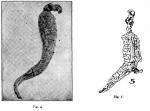
 Whether it will pay the growers to produce the best grade of root is a question. Certainly we have to stop producing the lowest grade. To produce the best, we must let our plants stand until they mature and begin to put on weight very slow. To get the very light, corky roots like the wild the last year or two practically no growth must be made. If the growers will allow their roots to stand until they are well ringed and if of good shape they can expect a good price, that is, if well dried. During the year 1913 just closed, the writer has sold at least a dozen crops of strictly cultivated roots to the Chinese for $9.25 to $10.00 per pound. One of these crops was sixty pounds of eight-year-old roots, grown in red clay, and averaged about the size and shape of Fig. 1, were quite heavy roots and did not resemble wild roots in that regard but were dried well and broke white. Another crop of over one hundred pounds, resembling Fig. 2 but a little larger, were sold for $10.00 per pound. Other crops, like Figs. 3 and 4, were sold for $9.00. These sales were made at a time when roots like Fig. 5 were not worth over $4.00 and roots like Fig. 6 were absolutely unsalable.
Whether it will pay the growers to produce the best grade of root is a question. Certainly we have to stop producing the lowest grade. To produce the best, we must let our plants stand until they mature and begin to put on weight very slow. To get the very light, corky roots like the wild the last year or two practically no growth must be made. If the growers will allow their roots to stand until they are well ringed and if of good shape they can expect a good price, that is, if well dried. During the year 1913 just closed, the writer has sold at least a dozen crops of strictly cultivated roots to the Chinese for $9.25 to $10.00 per pound. One of these crops was sixty pounds of eight-year-old roots, grown in red clay, and averaged about the size and shape of Fig. 1, were quite heavy roots and did not resemble wild roots in that regard but were dried well and broke white. Another crop of over one hundred pounds, resembling Fig. 2 but a little larger, were sold for $10.00 per pound. Other crops, like Figs. 3 and 4, were sold for $9.00. These sales were made at a time when roots like Fig. 5 were not worth over $4.00 and roots like Fig. 6 were absolutely unsalable.
To sum up cultivation as it affects quality, we find the roots must be matured or at least to have passed the stage of rapid growth. If you adopt the plan of taking up your plants every year, you can easily sort out the matured roots. It sometimes happens in rich soil that roots will rot before maturing. If you are afraid of this, when the roots have reached a good size, transplant into very sterile poor soil two years in this. It will make fine, high-priced roots of them.
Another point we must make in the summary is that a good root must be good shape. You can accomplish this by trimming and shallow working of soil. Here you may well ask why the Chinese demand a compact shape. Most of the better grade of roots are trimmed and boxed, a single root in a fancy box for retail trade and it follows that the waste in trimming a sprangly or long root would absorb the profit. A good root must be properly dried. Of this matter we will speak later.

 Fig. 7 is a very good shaped root but is immature and will not bring more than half what the same root of the same size would bring had it been matured so as to show the rings around the root. The left hand root in Fig. 6 is the poorest root of all, as you can see by the perfectly smooth skin, denoting a very hard, glassy texture. A good quality of root in breaking will break a little soft and not brittle, like a piece of glass. Fig. 8 shows four wild roots, natural size; all four of these roots barely outweighed Fig. 1, which is also natural size.
Fig. 7 is a very good shaped root but is immature and will not bring more than half what the same root of the same size would bring had it been matured so as to show the rings around the root. The left hand root in Fig. 6 is the poorest root of all, as you can see by the perfectly smooth skin, denoting a very hard, glassy texture. A good quality of root in breaking will break a little soft and not brittle, like a piece of glass. Fig. 8 shows four wild roots, natural size; all four of these roots barely outweighed Fig. 1, which is also natural size.
We will begin in a systematic way, with the location, planting and preparing of the ground for the Ginseng garden, writes a successful grower—C. H. Peterson—of Blue Earth County, Minn.
In choosing a location for a Ginseng garden, select one having a well-drained soil. Ginseng thrives best in wood loam soil that is cool and mellow, although any good vegetable garden soil will do very well. A southern slope should be avoided, as the ground gets too warm in summer and it also requires more shade than level or northern slope does. It is also apt to sprout too early in the spring, and there is some danger of its getting frosted, as the flower stem freezes very easily and no seed is the result.
Then, again, if you locate your garden on too low ground the roots are apt to rot and the freezing and thawing of wet ground is hard on Ginseng. Laying out a garden nothing is more important than a good system both for looks, convenience and the growth of your roots later on. Do your work well, as there is good money in raising Ginseng, and for your time you will be well repaid. Don't make one bed here and another there and a path where you happen to step, but follow some plan for them. I have found by experience that the wider the beds are, the better, providing that their width does not exceed the distance that you can reach from each path to center of bed to weed. For general purposes for beds 6 ½ ft. is used for paths 1 ½ ft. A bed 6 ½ ft. wide gives you 3 ¼ ft. to reach from each path to center of bed without getting on the beds, which would not be advisable. An 18 in. path is none too wide after a few years' growth, as the plants nearly cover this with foliage. This size beds and paths are just the right width for the system of lath shading I am using, making the combined distance across bed and path 8 ft., or 16 ft. for two beds and two paths, just right to use a 1x4 rough 16 ft fencing board to run across top of posts described later on.
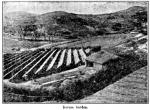
 Now we will lay out the garden by setting a row of posts 8 ft. apart the length you desire to make your garden. Then set another row 8 ft. from first row running parallel with first row, and so on until desired width of your garden has been reached. Be sure to have post line up both ways and start even at ends. Be sure to measure correctly. After all posts are set run a 1x4 in. rough fence board across garden so top edge is even at top of post and nail to post. The post should be about 8 ft. long so when set would be a trifle over 6 ft. above ground. This enables a person to walk under shading when completed. It is also cooler for your plants. In setting the posts do not set them too firm, so they can be moved at top enough to make them line up both ways. After the 1x4 in. fence board is put on we will nail on double pieces.
Now we will lay out the garden by setting a row of posts 8 ft. apart the length you desire to make your garden. Then set another row 8 ft. from first row running parallel with first row, and so on until desired width of your garden has been reached. Be sure to have post line up both ways and start even at ends. Be sure to measure correctly. After all posts are set run a 1x4 in. rough fence board across garden so top edge is even at top of post and nail to post. The post should be about 8 ft. long so when set would be a trifle over 6 ft. above ground. This enables a person to walk under shading when completed. It is also cooler for your plants. In setting the posts do not set them too firm, so they can be moved at top enough to make them line up both ways. After the 1x4 in. fence board is put on we will nail on double pieces.
Take a 1x6 rough fence board 16 ft. long and rip it so as to make two strips, one 3 ½ and the other 2 ½ inches wide, lay the 3 ½ in. flat and set the 2 ½ in. strip on edge in middle of other strip and nail together. This had better be done on the ground so it can be turned over to nail. Then start at one side and run this double piece lengthwise of your garden or crosswise of the 1x4 in. fence board nailed along top of post and nail down into same. It may be necessary to nail a small piece of board on side of the 1x4 in. board where the joints come. Then lay another piece similar to this parallel with first one, leaving about 49 ½ in. between the two. This space is for the lath panel to rest on the bottom piece of the double piece. Do not put double pieces so close that you will have to crowd the lath panels to get them in, but leave a little room at end of panel. You will gain about 1 ½ in. for every double piece used in running across the garden. This has to be made up by extending over one side or the other a piece of 1x4 board nailed to end of 1x4 board nailed at top posts. Let this come over the side you need the shade most. Begin from the side you need the shade least and let it extend over the other side.
It is advisable to run paths on outside of garden and extend the shading out over them. On sides lath can be used unless otherwise shaded by trees or vines. It will not be necessary to shade the north side if shading extends out over end of beds several feet. Give your plants all the air you can. In this system of shading I am using I have figured a whole lot to get the most convenient shading as well as a strong, substantial one without the use of needless lumber, which means money in most places. It has given good satisfaction for lath shade so far. Being easily built and handy to put on in spring and take off in fall.
Now don't think I am using all lath shade, as I am not. In one part of garden I am using lath and in another part I am using some good elm trees. I think, however, that the roots make more rapid growth under the lath shade, but the trees are the cheaper as they do not rot and have to be replaced. They also put on their own shade. The leaves when the proper time comes also removes it when the time comes in the fall and also mulches the beds at the same time.
We will now plan out the beds and paths. Use 1x4 in. rough 16 ft. fence boards on outside row of posts next to ground, nail these to posts, continue and do likewise on next row of posts, and so on until all posts have boards nailed on same side of them as first one, the post being just on inside edge of your beds. Then measure 6 ½ ft. toward next board, drive a row of stakes and nail a board of same width to same the length of your garden that will make 18 in. between last row of boards and boards on next row nailed to post for the path.
These boards answer several purposes, viz., keep people from walking on beds, elevates beds above paths, holds your mulching of leaves and adds to the appearance of your garden. After beds are made by placing the boards spade the ground about a foot deep all over the bed so as to work it up in good shape. After this is done fork it over with a six-tine fork. If bed is made in summer for fall or spring planting it is well to work it over several times during the summer, as the ground cannot be too mellow. This will also help kill the weeds. Then just before planting rake it down level.
In case beds are made in woods, cut, or better, grub out all trees not needed for shade, and if tree roots are not too large cut out all next to the surface running inside of boards in beds, and work the same as other beds. Lay out your beds same as for lath shade with paths between them. Don't try to plant Ginseng in the woods before making it into beds, as you will find it unsatisfactory.
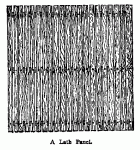 We will now make the lath panel before mentioned.
We will now make the lath panel before mentioned.
Place three laths so that when the laths are laid crosswise one of the laths will be in the middle and the other two, one at each end two inches from end. Can be placed at the end, but will rot sooner. Then begin at end of the three laths and nail lath on, placing them 1 in. apart until other end is reached, and if lath is green put closer together to allow for shrinkage. If you have many panels to make, make a table out of boards and lay strips of iron fastened to table where the three lath comes, so as to clinch nails when they strike the iron strips, which will save a lot of work. Gauges can also be placed on side of table to lay lath so they will be even at ends of panels when finished. Then lay panels in your double pieces on your garden, and if garden is not located in too windy a locality they will not blow out without nailing, and a wire drawn tight from end to end of garden on top of panels will prevent this, and is all that is necessary to hold them in place.
In Central New York, under favorable conditions, Ginseng plants should be coming up the last of April and early May, and should be in the ground by or before April 1st, to give best results. Healthy roots, taken up last of March or early April will be found covered with numerous fine hairlike rootlets. These are the feeders and have all grown from the roots during the spring. They should be well established in the soil before plants appear. Fifteen minutes exposure to the sun or wind will seriously injure and possibly destroy these fine feeders, forcing the roots to throw out a second crop of feeders.
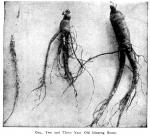 Considering these conditions and frequent late seasons, our advice to beginners is, wait until fall for transplanting roots. But we are not considering southern conditions. Southern growers must be governed by their own experience and climatic conditions. It may be a matter of convenience sometimes for a northern grower to take up one or two year seedlings and transplant to permanent beds in spring. If conditions are favorable so the work can be done in March or early April, it may be allowable. Have ground ready before roots are taken up. Only take up a few at a time, protect from sun and wind, transplant immediately.
Considering these conditions and frequent late seasons, our advice to beginners is, wait until fall for transplanting roots. But we are not considering southern conditions. Southern growers must be governed by their own experience and climatic conditions. It may be a matter of convenience sometimes for a northern grower to take up one or two year seedlings and transplant to permanent beds in spring. If conditions are favorable so the work can be done in March or early April, it may be allowable. Have ground ready before roots are taken up. Only take up a few at a time, protect from sun and wind, transplant immediately.
Spring sowing of old seed. By this we mean seed that should have been sowed the fall before when one year old, but has been kept over for spring sowing.
There is other work that can be done quite early in the Ginseng gardens. All weeds that have lived thru the winter should be pulled as soon as frost is out of ground. They can be pulled easier then than any other time and more certain of getting the weed root out. Mulching should be looked to. When coarse material like straw or leaves has been used, it should be loosened up so air can get to the soil and the plants can come up thru the mulch. If very heavy, perhaps a portion of the mulch may need to be removed, but don't! don't! take mulch all off from beds of set roots. Seed beds sown last fall will need to be removed about time plants are starting up. But seed beds should have been mulched with coarse leaf loam, or fine vegetable mulch, and well rotted horse manure (half and half), thoroughly mixed together, this mulch should have been put on as soon as seeds were sown and covered with mulch one inch deep. If this was not done last fall it should be put on this spring as soon as snow is off beds.
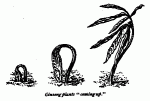 There is another point that needs careful attention when plants are coming up. On heavy soil plants are liable to be earth bound; this is quite likely to occur on old beds that have not been mulched and especially in dry seasons. As the Ginseng stalk comes out of the ground doubled (like an inverted U) the plant end is liable to be held fast by the hard soil, causing injury and often loss of plants. A little experience and careful observation will enable one to detect earth bound plants. The remedy is to loosen soil around the plant. A broken fork tine about eight inches long (straightened) and drive small end in a piece of broom handle about four inches long for a handle, flatten large end of tine like a screwdriver; this makes a handy tool for this work. Force it into soil near plant, give a little prying movement, at same time gently pull on plant end of stalk until you feel it loosen, do not try to pull it out, it will take care of itself when loosened. There is not likely to be any trouble, if leaves appear at the surface of soil. This little spud will be very useful to assist in pulling weed roots, such as dandelion, dock, etc.
There is another point that needs careful attention when plants are coming up. On heavy soil plants are liable to be earth bound; this is quite likely to occur on old beds that have not been mulched and especially in dry seasons. As the Ginseng stalk comes out of the ground doubled (like an inverted U) the plant end is liable to be held fast by the hard soil, causing injury and often loss of plants. A little experience and careful observation will enable one to detect earth bound plants. The remedy is to loosen soil around the plant. A broken fork tine about eight inches long (straightened) and drive small end in a piece of broom handle about four inches long for a handle, flatten large end of tine like a screwdriver; this makes a handy tool for this work. Force it into soil near plant, give a little prying movement, at same time gently pull on plant end of stalk until you feel it loosen, do not try to pull it out, it will take care of itself when loosened. There is not likely to be any trouble, if leaves appear at the surface of soil. This little spud will be very useful to assist in pulling weed roots, such as dandelion, dock, etc.
Where movable or open shades are used, they need not be put on or closed till plants are well up; about the time leaves are out on trees is the general rule. But one must be governed to some extent by weather and local conditions. If warm and dry, with much sun, get them on early. If wet and cool, keep them off as long as practicable, but be ready to get them on as soon as needed.
I would advise a would-be grower of Ginseng to visit, if possible, some gardens of other growers and learn all they can by inquiry and observation.
In selecting a place for your garden, be sure it has good drainage, as this one feature may save you a good deal of trouble and loss from "damping off," "wilt," and other fungus diseases which originate from too damp soil.
A light, rich soil is best. My opinion is to get soil from the forest, heap up somewhere for a while thru the summer, then sift thru sand sieve or something similar, and put about two inches on top of beds you have previously prepared by spading and raking. If the soil is a little heavy some old sawdust may be mixed with it to lighten it. The woods dirt is O. K. without using any commercial fertilizers. The use of strong fertilizers and improper drying is responsible for the poor demand for cultivated root. The Chinese must have the "quality" he desires and if flavor of root is poor, will not buy.
———
I wonder how many readers know that Ginseng can be grown in the house? writes a New York dealer.
Take a box about 5 inches deep and any size you wish. Fill it with woods dirt or any light, rich soil. Plant roots in fall and set in cellar thru the winter. They will begin to come up about April 1st, and should then be brought out of cellar. I have tried this two seasons. Last year I kept them by a window on the north side so as to be out of the sunshine. Window was raised about one inch to give ventilation. Two plants of medium size gave me about 100 seeds.
This season I have several boxes, and plants are looking well and most of them have seed heads with berries from one-third to three-fourths grown. They have been greatly admired, and I believe I was the first in this section to try growing Ginseng as a house plant.
———
As to the location for a Ginseng garden, I have for the past two years been an enthusiast for cultivation in the natural forest, writes L. C. Ingram, M. D., of Minnesota. It is true that the largest and finest roots I have seen were grown in gardens under lattice, and maintaining such a garden must be taken into account when balancing your accounts for the purpose of determining the net profits, for it is really the profits we are looking for.
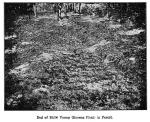 The soil I have found to be the best, is a rich black, having a good drain, that is somewhat rolling. As to the direction of this slope I am not particular so long as there is a rich soil, plenty of shade and mulch covering the beds.
The soil I have found to be the best, is a rich black, having a good drain, that is somewhat rolling. As to the direction of this slope I am not particular so long as there is a rich soil, plenty of shade and mulch covering the beds.
The selection of seed and roots for planting is the most important item confronting the beginner. Considerable has been said in the past concerning the distribution among growers of Japanese seed by unscrupulous seed venders. It is a fact that Japanese Ginseng seed have been started in a number of gardens, and unless successfully stamped out before any quantity finds its way into the Chinese market, the Ginseng industry in America, stands in peril of being completely destroyed. Should they find our root mixed, their confidence would be lost and our market lost. Every one growing Ginseng must be interested in this vital point, and if they are suspicious of any of their roots being Japanese, have them passed upon by an expert, and if Japanese, every one dug.
It is a fact that neighboring gardens are in danger of being mixed, as the bees are able to do this in carrying the mixing pollen. The safest way to make a start is by procuring seed and roots from the woods wild in your own locality. If this cannot be done then the seed and roots for a start should be procured from a reliable party near you who can positively guarantee the seed and roots to be genuine American Ginseng. We should not be too impatient and hasty to extend the garden or launch out in a great way. Learn first, then increase as the growth of new seed will permit.
The next essential thing is the proper preparation of the soil for the planting of the seeds and roots. The soil must be dug deep and worked perfectly loose same as any bed in a vegetable garden. The beds are made four or five feet wide And raised four to six inches above the paths, which are left one and a half to two feet wide. I have had seed sown on the ground and covered with dirt growing beside seed planted in well trade beds and the contrast in size and the thriftiness of roots are so great when seen, never to be forgotten. The seedlings growing in the hard ground were the size of oat kernels, those in the beds beside them three to nine inches, long and weighing from four to ten times as much per root.
In planting the seed all that is necessary is to scatter the stratified seed on top of the prepared bed so they will be one or two inches apart, then cover with loose dirt from the next bed then level with back of garden rake. They should be one-half to one inch covered. Sawdust or leaves should next be put on one to two inches for a top dressing to preserve moisture, regulate heat, and prevent the rains from packing the soil.
The best time to do all planting is in the spring. This gives the most thrifty plants with the least number missing. When the plants are two years old they must be transplanted into permanent beds. These are prepared in the same manner as they were for the seed. A board six inches wide is thrown across the bed, you step on this and with a spade throw out a ditch along the edge of the board. In this the roots are set on a slant of 45 degrees and so the bud will be from one to two inches beneath the surface. The furrow is then filled and the board moved its width. By putting the roots six inches apart in the row and using a six-inch board your plants will be six inches each way, which with most growers have given best results. When the roots have grown three years in the transplanted beds they should be ready to dig and dry for market. They should average two ounces each at this time if the soil was rich in plant food and properly prepared and cared for.
The plants require considerable care and attention thru each summer. Moles must be caught, blight and other diseases treated and the weeds pulled, especially from among the younger plants. As soon as the plants are up in the spring the seed buds should be clipped from all the plants except those finest and healthiest plants you may save for your seed to maintain your garden. The clipping of the seed buds is very essential, because we want the very largest and best flavored root in the shortest time for the market. Then if we grow bushels of seed to the expense of the root, it is only a short time when many thousands of pounds of root must compete with our own for the market and lower the price
Ginseng and Other Medicinal Plants, 1936, was written by A. R. Harding.

